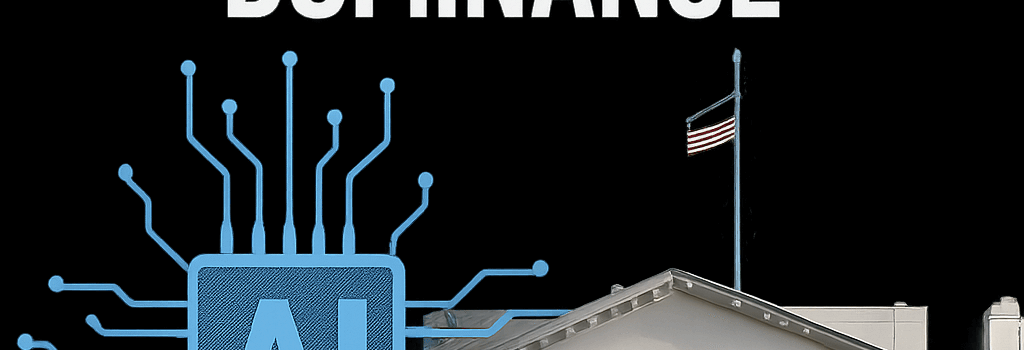White House AI Action Plan: Deregulation and Global Dominance

In July 2025, the White House released its landmark 25-page strategy, “Winning the Race: America’s AI Action Plan,” aimed at cementing U.S. leadership in artificial intelligence through sweeping deregulation, massive infrastructure investments, and targeted international partnerships. Spearheaded by Assistant to the President for Science and Technology Michael J. Kratsios and Special Advisor for AI and Crypto David O. Sacks, the plan has reignited debates over how to strike the right balance between innovation, safety, energy usage, and global competitiveness.
Key Pillars of the AI Action Plan
- Innovation: Remove “unnecessary” regulatory barriers—repealing Biden-era measures such as Executive Order 14110 on AI model safety—and update the NIST AI Risk Management Framework to focus strictly on technical robustness, excluding references to misinformation, Diversity, Equity & Inclusion (DEI), and climate change.
- Infrastructure: Streamline NEPA permitting, open federal lands for hyperscale data center construction, modernize the grid, and reinvigorate domestic semiconductor fabrication via a trimmed-down CHIPS Program Office.
- International Diplomacy: Forge new alliances with G7 and Quad partners, subsidize exports of open-source models (e.g., LLaMA, Stable Diffusion derivatives), and curtail adversaries’ access to high-end AI accelerators through tightened export controls (e.g., NVIDIA A100, AMD MI250X).
Technical Deep Dive: Data Center Energy Efficiency
AI workloads have driven data center power demands to unprecedented levels. Current estimates place AI-related energy consumption at 1.8% of global electricity, with projections hitting 6% by 2030. The plan calls for:
- Advanced Cooling Systems: Incentives for immersion cooling and liquid-to-chip heat exchangers, reducing Power Usage Effectiveness (PUE) from 1.2 to near 1.1.
- Onsite Generation: Deployment of modular gas-turbine generators and small nuclear reactors under a revised Defense Production Act authority, providing up to 500 MW footprints for hyperscale AI clusters.
- Renewable Integration: Grants for grid-scale batteries and solar-plus-storage co-located at data center campuses to smooth intermittent loads caused by large inference jobs.
“Optimizing PUE and reducing carbon intensity per inference will be critical if the U.S. wants to scale AI responsibly,” notes Dr. Jane Patel, senior researcher at the National Renewable Energy Laboratory.
Global Geopolitical and Export Control Implications
The plan positions AI supremacy as the new Space Race, warning that “whoever leads in AI sets global standards and reaps economic and military advantages.” Highlights include:
- Export Controls: Expansion of the Commerce Department’s Entity List to block sales of AI silicon (e.g., HBM3-enabled GPUs) to nation-state actors, mirroring recent EAR updates targeted at China’s SMIC and Canaan.
- Allied Technology Sharing: A joint U.S.-EU task force to align the American deregulation approach with Europe’s AI Act, ensuring interoperability for safety labels and standardized APIs.
- Offshore Talent Pipelines: Fast-track visas for top-tier AI researchers, alongside new consortia with India and Australia for shared HPC cluster time on DOE supercomputers like Frontier and Aurora.
Economic and Workforce Impact
Critics argue the administration’s strategy favors Big Tech profits over public welfare. Public Citizen’s J.B. Branch warns of rising electricity costs and under-regulated AI deployments. In response, over 90 organizations unveiled the “People’s AI Action Plan,” demanding stricter environmental assessments and robust safety testing before broad deployment.
“We cannot let unaccountable AI rollout erode workers’ wages or jeopardize patient safety,” emphasizes Cathy Kennedy, RN, president of National Nurses United.
Skills and Re-skilling Initiatives
The White House plan includes $500 million in grants for community colleges to develop AI curricula—covering MLOps pipelines, distributed training on Kubernetes clusters, and fundamentals of model interpretability (SHAP, LIME).
Regulatory Revisions and Agency Directives
The Office of Management and Budget (OMB) has been instructed to:
- Audit existing AI-related rules across 25 federal agencies and propose rollbacks within 180 days.
- Charge the Federal Trade Commission (FTC) with reviewing prior AI liability theories—especially around algorithmic bias—to avoid “overreaching enforcement.”
Meanwhile, the National Institute of Standards and Technology (NIST) is slated to release AI Risk Management Framework 2.0 later this year, emphasizing adversarial robustness and computational reproducibility benchmarks over societal impact metrics.
Additional Analysis: Balancing Innovation and Safety
While deregulation accelerates deployment, leading AI labs like OpenAI, Anthropic, and Google DeepMind have independently committed to internal red-teaming and multi-stage safety evaluations. Experts caution that unchecked model release—particularly of multi-modal transformers exceeding 200 billion parameters—could elevate risks of misinformation and autonomous cyberattacks.
“Industry self-regulation can complement, but not replace, thoughtfully calibrated government standards,” says Dr. Alan F. Sherman of MIT’s Computer Science & Artificial Intelligence Laboratory.
Latest Developments
- August 2025: The Senate passed the National AI Competitiveness Act, allocating $2 billion for exascale R&D and public-private AI testbeds.
- July 2025: The EU officially adopted the AI Act, introducing a high-risk classification system that the U.S. plan seeks to align with through bilateral talks.
- June 2025: China’s Ministry of Industry issued new guidelines for domestic generative AI startups, enforcing data-localization and pre-release security audits.
Conclusion
The Trump administration’s AI Action Plan marks a decisive pivot toward deregulation and bold infrastructure spending. As Congress debates companion legislation and international partners adjust their AI governance frameworks, the coming months will reveal whether the U.S. can “win the race” without compromising safety, equity, or environmental sustainability.